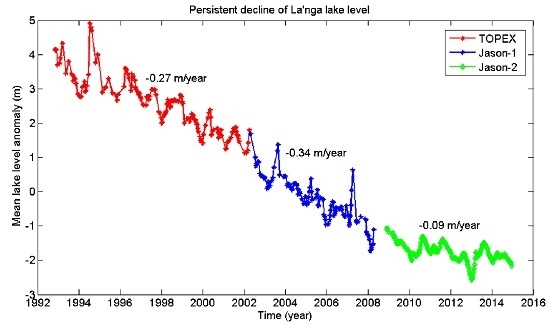Multi-Decadal Monitoring of Lake Level Changes in the Qinghai-Tibet Plateau by the TOPEX/Poseidon-Family Altimeters: Climate Implication
Abstract
:1. Introduction
2. Radar Altimeter Data of TOPEX/Poseidon-Family Satellites for Lake Level Change
3. Determining Reliable Lake Levels from Radar Measurements
3.1. Improving Lake Level Measurements by Retracking Waveforms
3.2. Constructing Lake Level Time Series at 23 Lakes
- I.
- Select the best data session over a lake
- II.
- Average heights from measurements in a cycle to form a representative height
- III.
- Form time series of lake level changes
4. Result
4.1. Trends of Lake Level Change: An Overview
4.2. Assessment of Lake Level Changes
4.3. Analyses of Lake Level Changes at Selected Lakes
- (I)
- Lakes with varying lake level trends
- (1)
- Large annual oscillations occurred before the 1997–1998 El Niño. With the lake level beginning to rise since June 1998, the amplitude of oscillation decreased. This indicates that a smaller lake body (before June 1998) is more sensitive to water influx change than a larger body (after June 1998). The lake level lows vary from May to June, indicating different onset times of snow melting. The most striking feature is: the highs consistently occurred in December over January 1993–December 2014.
- (2)
- Lake levels at Dagze Co and Gyarab Co underwent large annual oscillations before and after the 1997–1998 El Niño. In comparison to Ngangzi, the lake level highs occurred in autumn and the lows in early spring.
- (II)
- Lakes with continuous dropping trends—La’nga (No. 22), Zhapu (No. 23), and Margog Caka (No. 11)
- (III)
- Lakes with continuous rising trends—Zhangnai (No. 13), Zige (No. 5), and Chibuzhang (No. 6)
5. Discussions
5.1. Lakes with Steady Lake Trends: Contribution of Precipitation
5.2. Inter-Altimeter Bias and Adding ERS-Family Satellites to Increase Lake Coverage
5.3. Advantage of Radar Altimeter: Not Only Laser Altimeter Is Needed
6. Conclusions
Acknowledgments
Author Contributions
Conflicts of Interest
References
- Zhang, G.; Xie, H.; Kang, S.; Yi, D.; Ackley, S.F. Monitoring lake level changes on the Tibetan Plateau using ICESat altimetry data (2003–2009). Remote Sens. Environ. 2011, 115, 1733–1742. [Google Scholar] [CrossRef]
- Li, L.; Wang, W. The response of lake change to climate fluctuation in north Qinghai-Tibet Plateau in last 30 years. J. Geog. Sci. 2009, 19, 131–142. [Google Scholar]
- Liu, X.; Chen, B. Climatic warming in the Tibetan Plateau during recent decades. Int. J. Climatol. 2000, 20, 1729–1742. [Google Scholar] [CrossRef]
- Huang, W.; Liao, J.; Shen, G. Lake change in past 40 years in the southern Nagqu District of Tibet and analysis of its driving forces. Remote Sens. Land Resour. 2012, 24, 122–128. (In Chinese) [Google Scholar]
- Qiu, J. The third pole. Nature 2008, 454, 393–396. [Google Scholar] [CrossRef] [PubMed]
- Shao, Z.; Zhu, D.; Meng, X.; Zheng, D.; Qiao, Z.; Yang, C.; Han, J.; Yu, J.; Meng, Q.; Lü, R. Characteristics of the change of major lakes on the Qinghai-Tibet Plateau in the last 25 years. Front. Earth Sci. China 2008, 2, 364–377. [Google Scholar] [CrossRef]
- Yao, X.; Liu, S.; Li, L.; Sun, M.; Luo, J. Spatial-Temporal characteristics of lake area variations in Hoh Xil region from 1970 to 2011. J. Geograph. Sci. 2014, 24, 689–702. [Google Scholar] [CrossRef]
- Morris, C.S.; Gill, S.K. Evaluation of the TOPEX/POSEIDON altimeter system over the Great Lakes. J. Geophys. Res. 1994, 99, 24527–24539. [Google Scholar] [CrossRef]
- Alsdorf, D.; Birkett, C.; Dunne, T.; Melack, J.; Hess, L. Water level changes in a large Amazon lake measured with space borne radar interferometry and altimetry. Geophys. Res. Lett. 2001, 28, 2671–2674. [Google Scholar] [CrossRef]
- Hwang, C.; Peng, M.F.; Ning, J.; Luo, J.; Sui, C.H. Lake level variations in China from TOPEX/Poseidon altimetry: Data quality assessment and links to precipitation and ENSO. Geophys. J. Int. 2005, 161, 1–11. [Google Scholar] [CrossRef]
- Song, C.; Huang, B.; Ke, L.; Richards, K.S. Seasonal and abrupt changes in the water level of closed lakes on the Tibetan Plateau and implications for climate impacts. J. Hydrol. 2014, 514, 131–144. [Google Scholar] [CrossRef]
- Kleinherenbrink, M.; Lindenbergh, R.C.; Ditmar, P.G. Monitoring of lake level changes on the Tibetan Plateau and Tian Shan by retracking Cryosat SARIn waveforms. J. Hydrol. 2015, 521, 119–131. [Google Scholar] [CrossRef]
- Aviso User Handbook—Merged TOPEX/POSEIDON Products (GDR-Ms). Available online: http://www.aviso.altimetry.fr/fileadmin/documents/data/tools/hdbk_tp_gdrm.pdf (accessed on 22 May 2016).
- OSTM/Jason-1 Products Handbook. Available online: http://www.aviso.altimetry.fr/fileadmin/documents/data/tools/hdbk_j1_gdr.pdf (accessed on 22 May 2016).
- OSTM/Jason-2 Products Handbook. Available online: http://www.aviso.altimetry.fr/fileadmin/documents/data/tools/hdbk_j2.pdf (accessed on 22 May 2016).
- French space agency AVISO. Available online: http://www.aviso.altimetry.fr/ (accessed on 22 May 2016).
- Frappart, F.; Calmant, S.; Cauhopé, M.; Seyler, F.; Cazenave, A. Preliminary results of ENVISAT RA-2-derived water levels validation over the Amazon basin. Remote Sens. Environ. 2006, 100, 252–264. [Google Scholar] [CrossRef] [Green Version]
- Yan, L.; Zheng, M. The response of lake variations to climate change in the past forty years: A case study of the northeastern Tibetan Plateau and adjacent areas, China. Quat. Int. 2015, 371, 31–48. [Google Scholar] [CrossRef]
- Zhu, D.; Zhao, X.; Meng, X.; Wu, Z.; Shao, Z.; Ma, Z.; Yang, Z.; Wang, J. Lake-Level fluctuation of Nam Co, Tibet, since the late Pleistocene, and evolution of an ancient large lake on the northern Tibetan Plateau. Geol. Bull. China 2003, 22, 918–927. (In Chinese) [Google Scholar]
- Yan, L.; Zheng, M. Influence of climate change on saline lakes of the Tibet Plateau, 1973–2010. Geomorphology 2015, 246, 68–78. [Google Scholar] [CrossRef]
- Zheng, M. An Introduction to Saline Lakes on the Qinghai—Tibet Plateau; Kluwer Academic Publishers: Dordrecht, The Netherlands, 1997. [Google Scholar]
- Taylor, M.; Yin, A.; Ryerson, F.J.; Kapp, P.; Ding, L. Conjugate strike-slip faulting along the Bangong-Nujiang suture zone accommodates coeval east-west extension and north-south shortening in the interior of the Tibetan Plateau. Tectonics. 2003, 22. [Google Scholar] [CrossRef]
- Becker, J.J.; Sandwell, D.T.; Smith, W.H.F.; Braud, J.; Binder, B.; Depner, J.; Fabre, D.; Factor, J.; Ingalls, S.; Kim, S.-H.; et al. Global bathymetry and elevation data at 30 arc seconds resolution: SRTM30_PLUS. Mar. Geod. 2009, 32, 355–371. [Google Scholar] [CrossRef]
- Shum, C.; Yi, Y.; Cheng, K.; Kuo, C.; Braun, A.; Calmant, S.; Chambers, D. Calibration of JASON-1 altimeter over lake erie special issue: Jason-1 calibration/validation. Mar. Geod. 2003, 26, 335–354. [Google Scholar] [CrossRef]
- Lee, H.K. Radar Altimetry Methods for Solid Earth Geodynamics Studies. Ph.D. Thesis, The Ohio State University, Columbus, OH, USA, 2008. [Google Scholar]
- Martin, T.V.; Zwally, H.J.; Brenner, A.C.; Bindschadler, R.A. Analysis and retracking of continental ice sheet radar altimeter waveforms. J. Geophys. Res. 1983, 88, 1608–1616. [Google Scholar] [CrossRef]
- Wingham, D.J.; Rapley, C.G.; Griffiths, H. New techniques in satellite altimeter tracking systems. In Proceedings of the 1986 International Geoscience and Remote Sensing Symposium (IGARSS’86) on Remote Sensing: Today’s Solutions for Tomorrow’s Information Needs; ESA Publication Division: Noordwijk, The Netherlands, 1986; Volume 3, pp. 1339–1344. [Google Scholar]
- Laxon, S. Sea ice altimeter processing scheme at the EODC. Int. J. Remote Sens. 1994, 15, 915–924. [Google Scholar] [CrossRef]
- Davis, C.H. A robust threshold retracking algorithm for measuring ice-sheet surface elevation change from satellite radar altimeters. IEEE Trans. Geosci. Remote Sens. 1997, 35, 974–979. [Google Scholar] [CrossRef]
- Hwang, C.; Guo, J.; Deng, X.; Hsu, H.Y.; Liu, Y. Coastal gravity anomalies from retracked Geosat/GM altimetry: Improvement, limitation and the role of airborne gravity data. J. Geod. 2006, 80, 204–216. [Google Scholar] [CrossRef]
- Yang, Y.; Hwang, C.; Hsu, H.J.; Dongchen, E.; Wang, H. A subwaveform threshold retracker for ERS-1 altimetry: A case study in the Antarctic Ocean. Comput. Geosci. 2012, 41, 88–98. [Google Scholar] [CrossRef]
- Yang, Y.; Hwang, C.; Dongchen, E. A fixed full-matrix method for determining ice sheet height change from satellite altimeter: An ENVISAT case study in East Antarctica with backscatter analysis. J. Geod. 2014, 88, 901–914. [Google Scholar] [CrossRef]
- Hsiao, Y.S.; Hwang, C.; Cheng, Y.S.; Chen, L.C.; Hsu, H.J.; Tsai, J.H.; Liu, C.L.; Wang, C.C.; Liu, Y.C.; Kao, Y.C. High-Resolution depth and coastline over major atolls of South China Sea from satellite altimetry and imagery. Remote Sens. Environ. 2016, 176, 69–83. [Google Scholar] [CrossRef]
- Brown, G.S. The average impulse response of a rough surface and its applications. IEEE Trans. Antennas Propag. 1977, 25, 67–74. [Google Scholar] [CrossRef]
- Dabo-Niang, S.; Ferraty, F.; Vieu, P. On the using of modal curves for radar waveforms classification. Comput. Stat. Data Anal. 2007, 51, 4878–4890. [Google Scholar] [CrossRef]
- Yao, T.; Thompson, L.; Yang, W.; Yu, W.; Gao, Y.; Guo, X.; Yang, X.; Duan, K.; Zhao, H.; Xu, B. Different glacier status with atmospheric circulations in Tibetan Plateau and surroundings. Nat. Clim. Chang. 2012, 2, 663–667. [Google Scholar] [CrossRef]
- Wang, R.; Giese, E.; Gao, Q.Z. The recent change of water level in the Bosten Lake and analysis of its causes. J. Glaciol. Geocryol. 2003, 25, 60–64. (In Chinese) [Google Scholar]
- Wang, R.; Sun, Z.; Gao, Q.Z. Water level change in Bosten Lake under the climate variation background of Central Asian ariund 2002. J. Glaciol. Geocryol. 2006, 28, 324–329. (In Chinese) [Google Scholar]
- Menne, M.J.; Durre, I.; Gleason, B.G.; Houston, T.G.; Vose, R.S. An overview of the global historical climatology network-daily database. J. Atmos. Ocean. Technol. 2012, 29, 897–910. [Google Scholar] [CrossRef]
- Hu, Y.; Maskey, S.; Uhlenbrook, S.; Zhao, H. Streamflow trends and climate linkages in the source region of the Yellow River, China. Hydrol. Process. 2011, 25, 3399–3411. [Google Scholar] [CrossRef]
- Guangming Online, Ideology and Culture in China. Available online: http://epaper.gmw.cn/gmrb/html/2013-08/04/nbs.D110000gmrb_03.htm/ (accessed on 22 May 2016).
- Administrative Bureau of Hoh Xil National Nature Reserve. Available online: http://www.kkxl.org.cn/ (accessed on 22 May 2016).
- Xiaojun, Y.; Shiyin, L.; Meiping, S. Changes of Kusai Lake in Hoh Xil region and causes of its water overflowing. Acta Geograph. Sin. 2012, 67, 689–698. (In Chinese) [Google Scholar]
- Fujita, K.; Sakai, A.; Takenaka, S.; Nuimura, T.; Surazakov, A.B.; Sawagaki, T.; Yamanokuchi, T. Potential flood volume of Himalayan glacial lakes. Nat. Hazards Earth Syst. Sci. 2013, 13, 1827–1839. [Google Scholar] [CrossRef]
- Liu, J.J.; Cheng, Z.L.; Li, Y. The 1988 glacial lake outburst flood in Guangxieco Lake, Tibet, China. Nat. Hazard. Earth Syst. 2014, 14, 3065–3075. [Google Scholar] [CrossRef]
- Niño 3.4 SST Index. Available online: http://www.esrl.noaa.gov/psd/gcos_wgsp/Timeseries/Nino34/ (accessed on 22 May 2016).
- Pu, J.C.; Yao, T.D.; Yang, M.X.; Tian, L.D.; Wang, N.L.; Ageta, Y.; Fujita, K. Rapid decrease of mass balance observed in the Xiao (Lesser) Dongkemadi Glacier, in the central Tibetan Plateau. Hydrol. Process. 2008, 22, 2953–2958. [Google Scholar] [CrossRef]
- Fu, L.L.; Haines, B.J. The challenges in long-term altimetry calibration for addressing the problem of global sea level change. Adv. Space Res. 2013, 51, 1284–1300. [Google Scholar] [CrossRef]
- Phan, V.H.; Lindenbergh, R.; Menenti, M. ICESat derived elevation changes of Tibetan lakes between 2003 and 2009. Int. J. Appl. Earth Observ. Geoinform. 2012, 17, 12–22. [Google Scholar] [CrossRef]
- Phan, V.H.; Lindenbergh, R.; Menenti, M. Seasonal trends in Tibetan lake level changes as observed by ICESat laser altimetry. ISPRS Int. Ann. Photogramm. Remote Sens. Spat. Inf. Sci. 2012, 1, 237–242. [Google Scholar] [CrossRef]
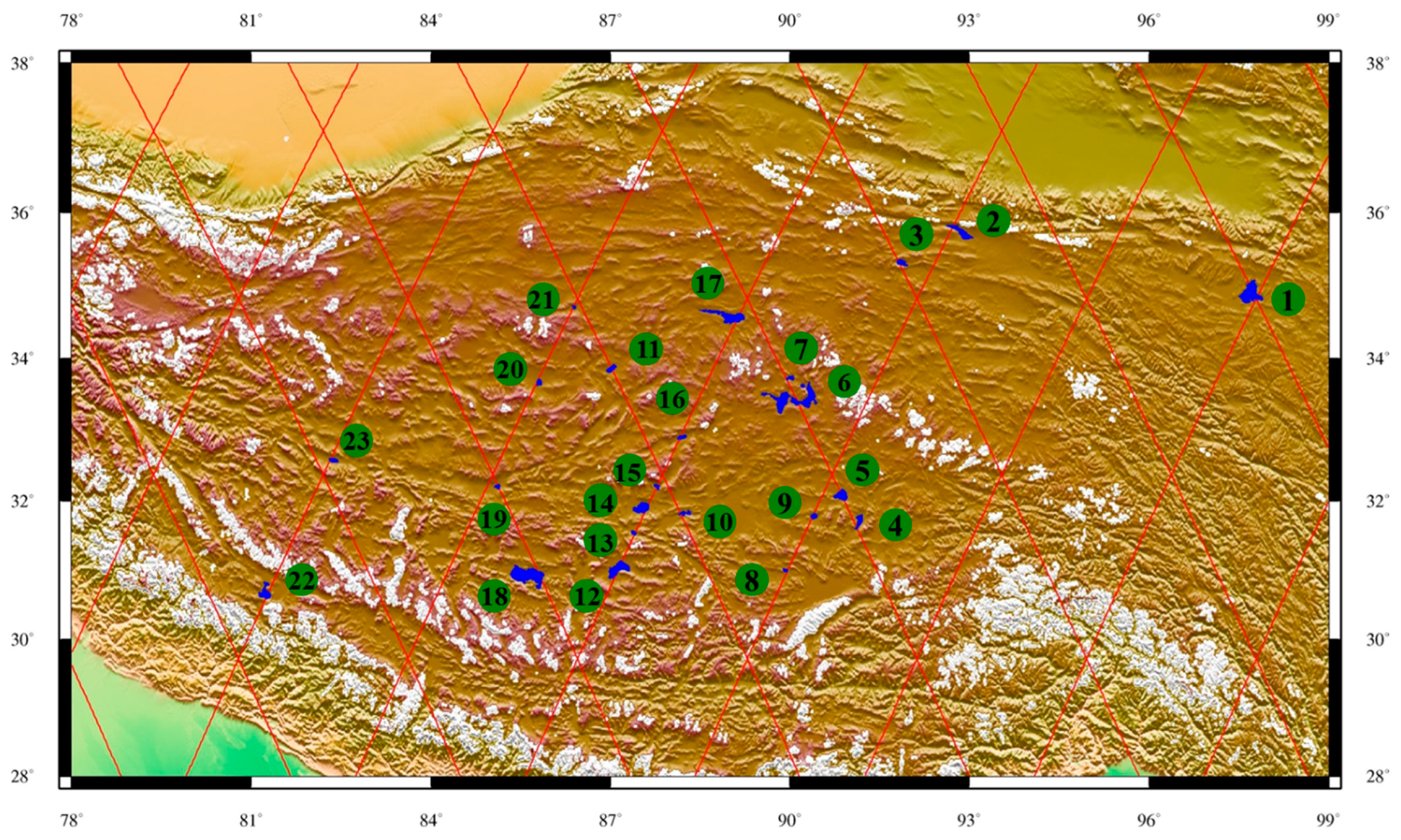
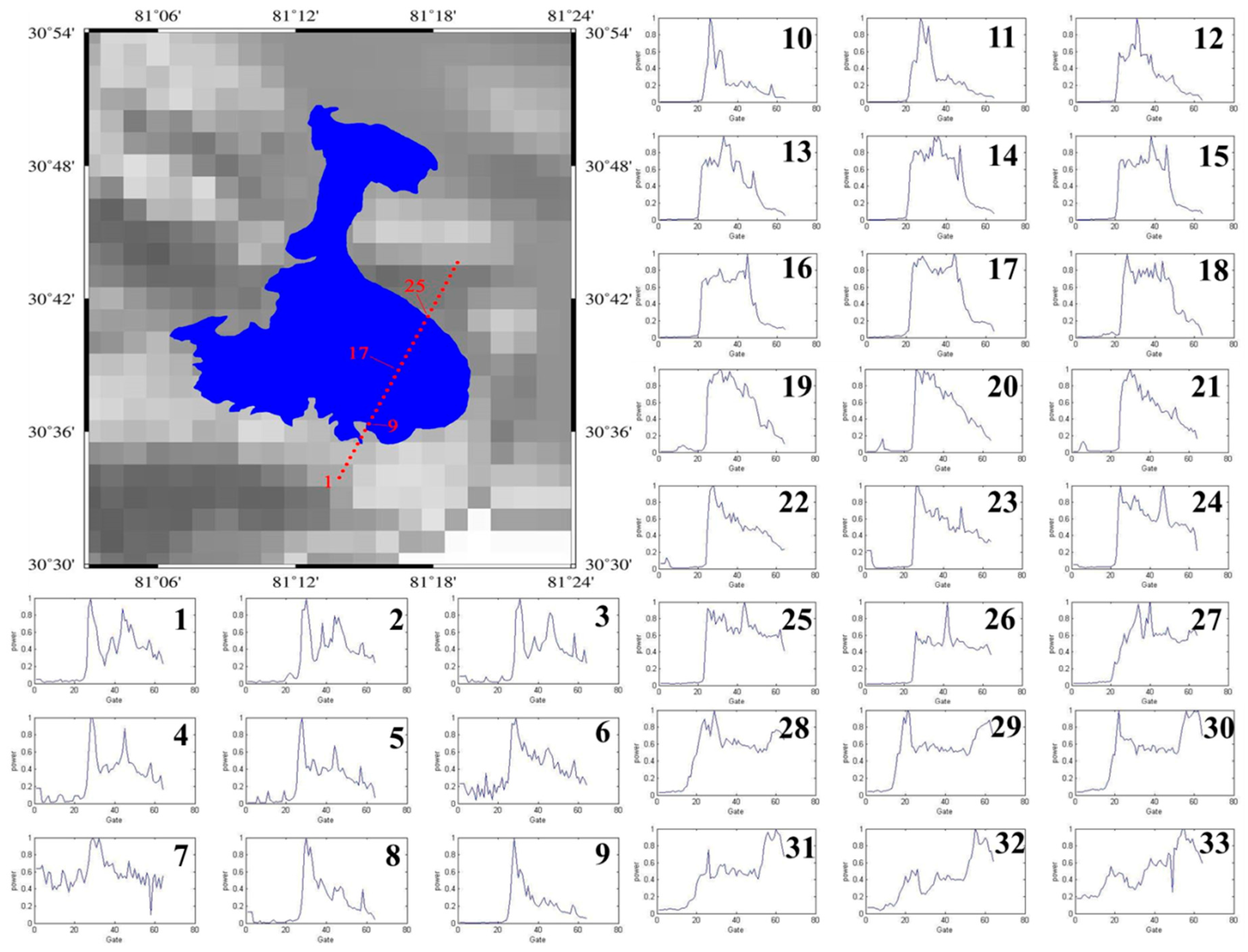

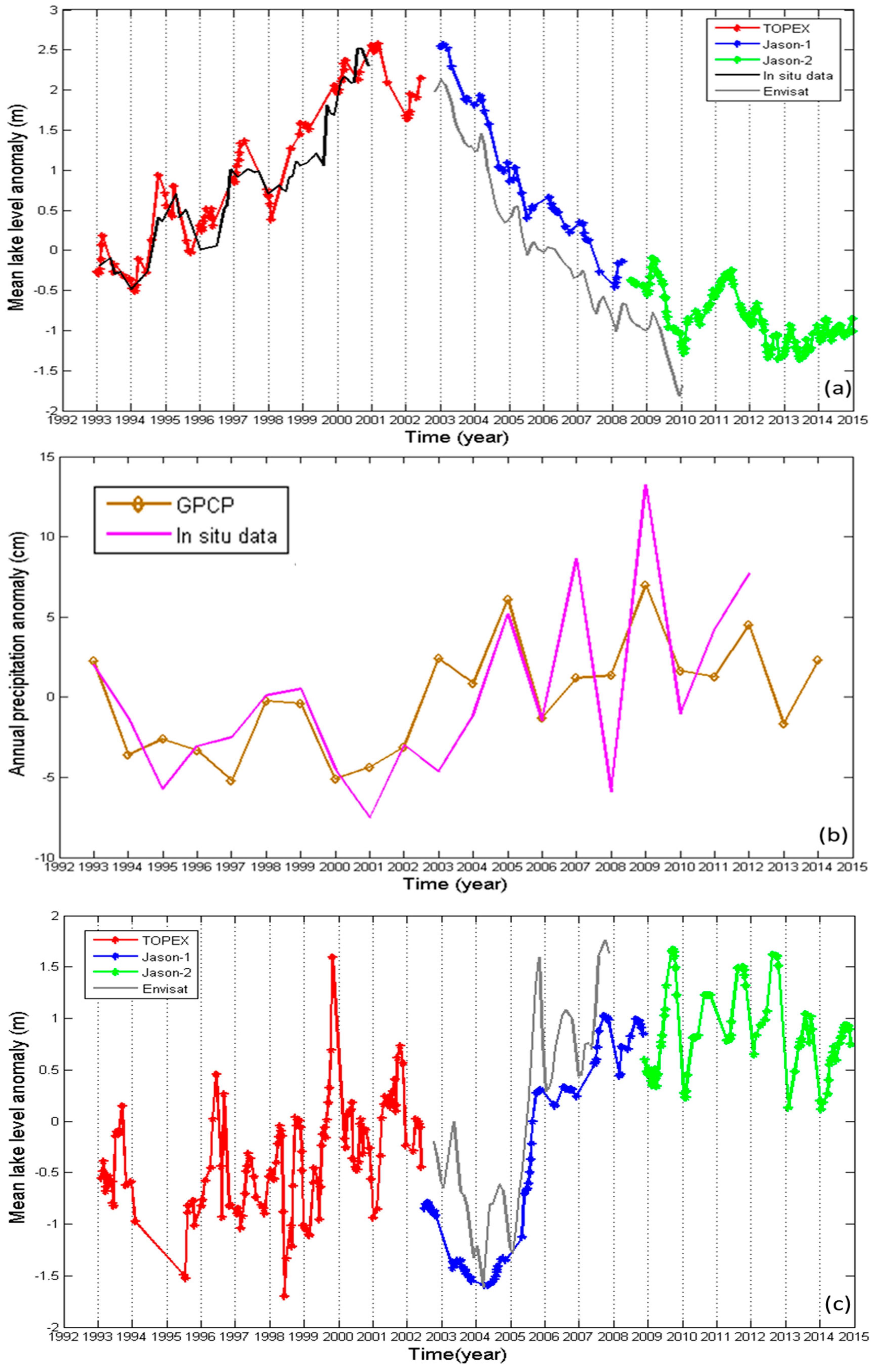

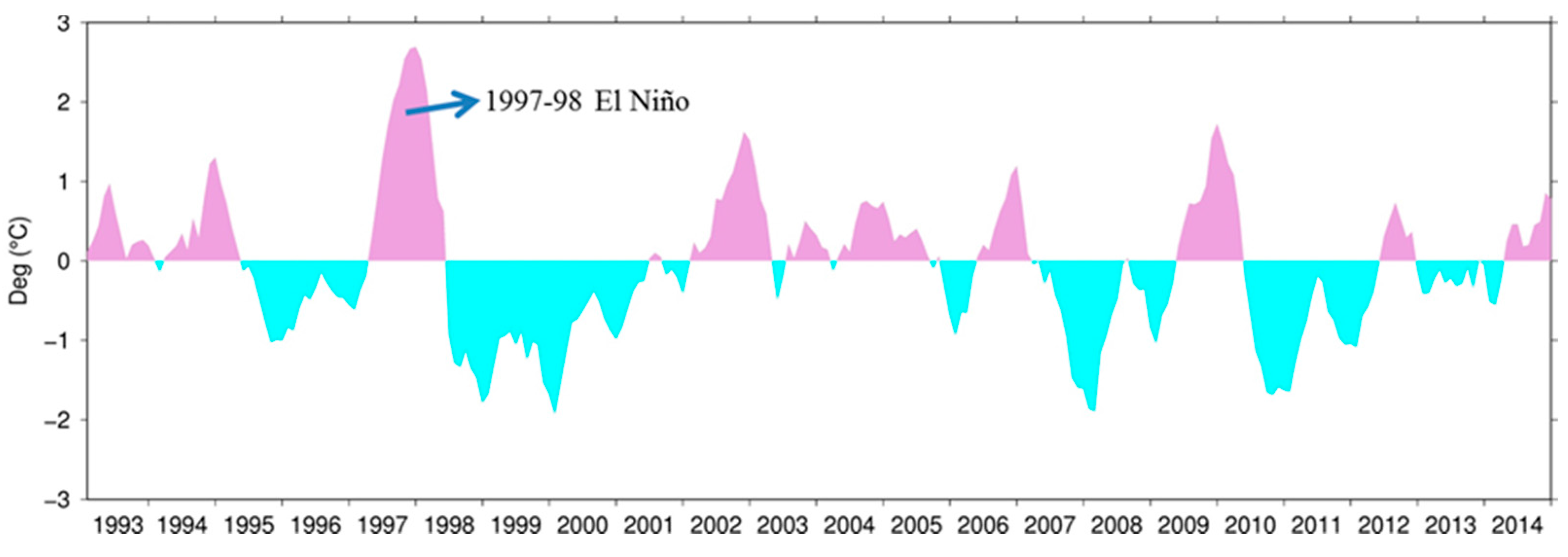
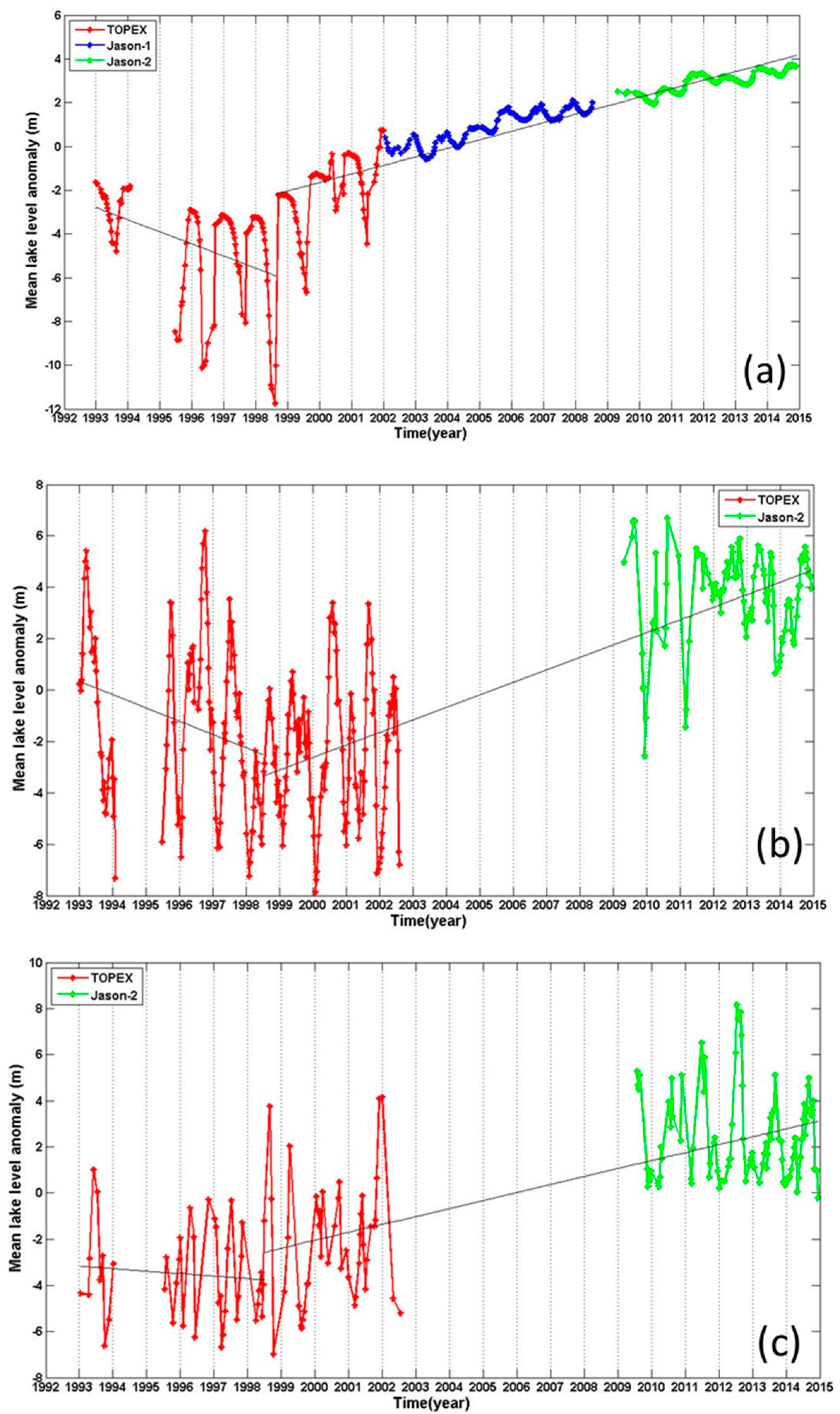
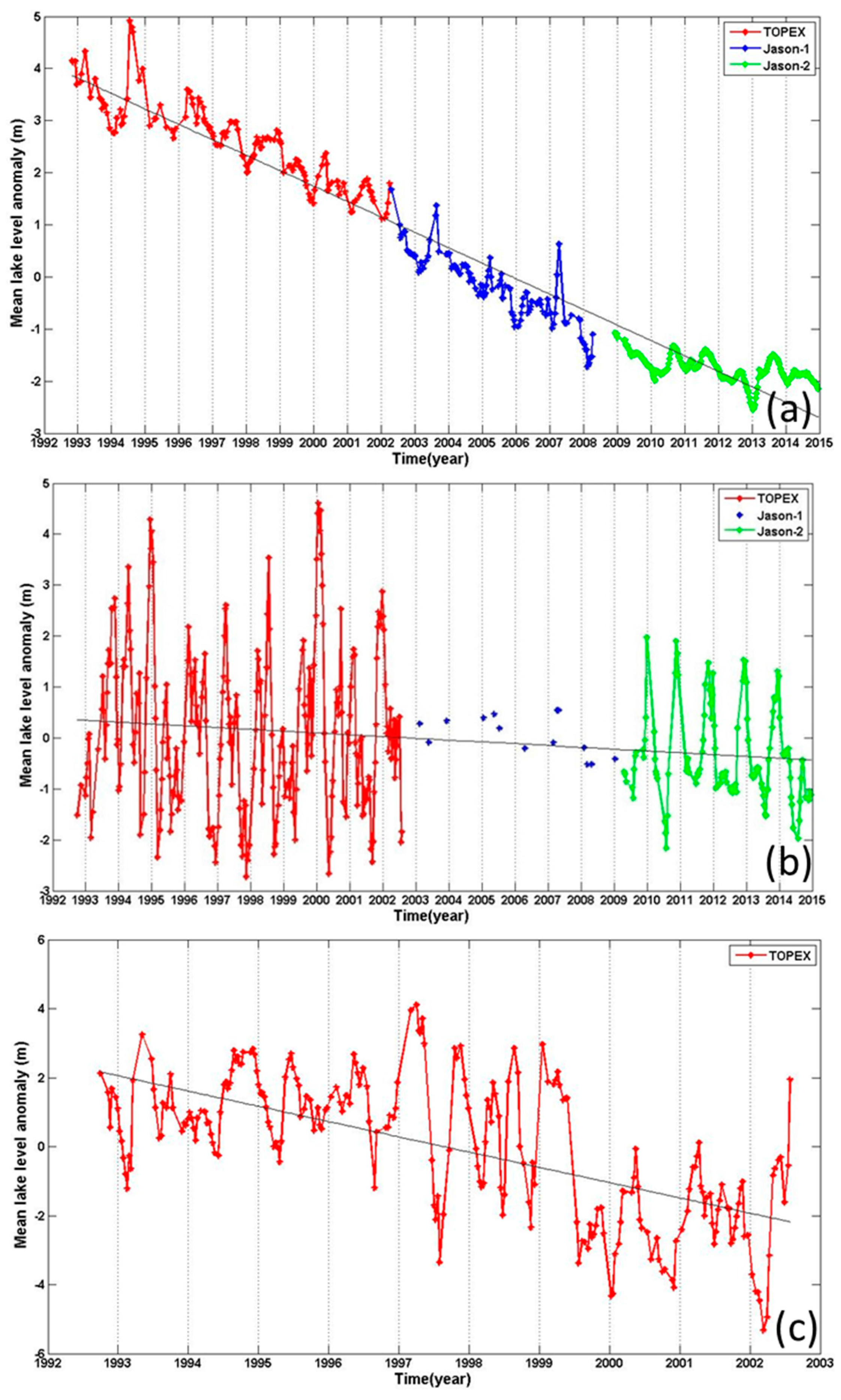
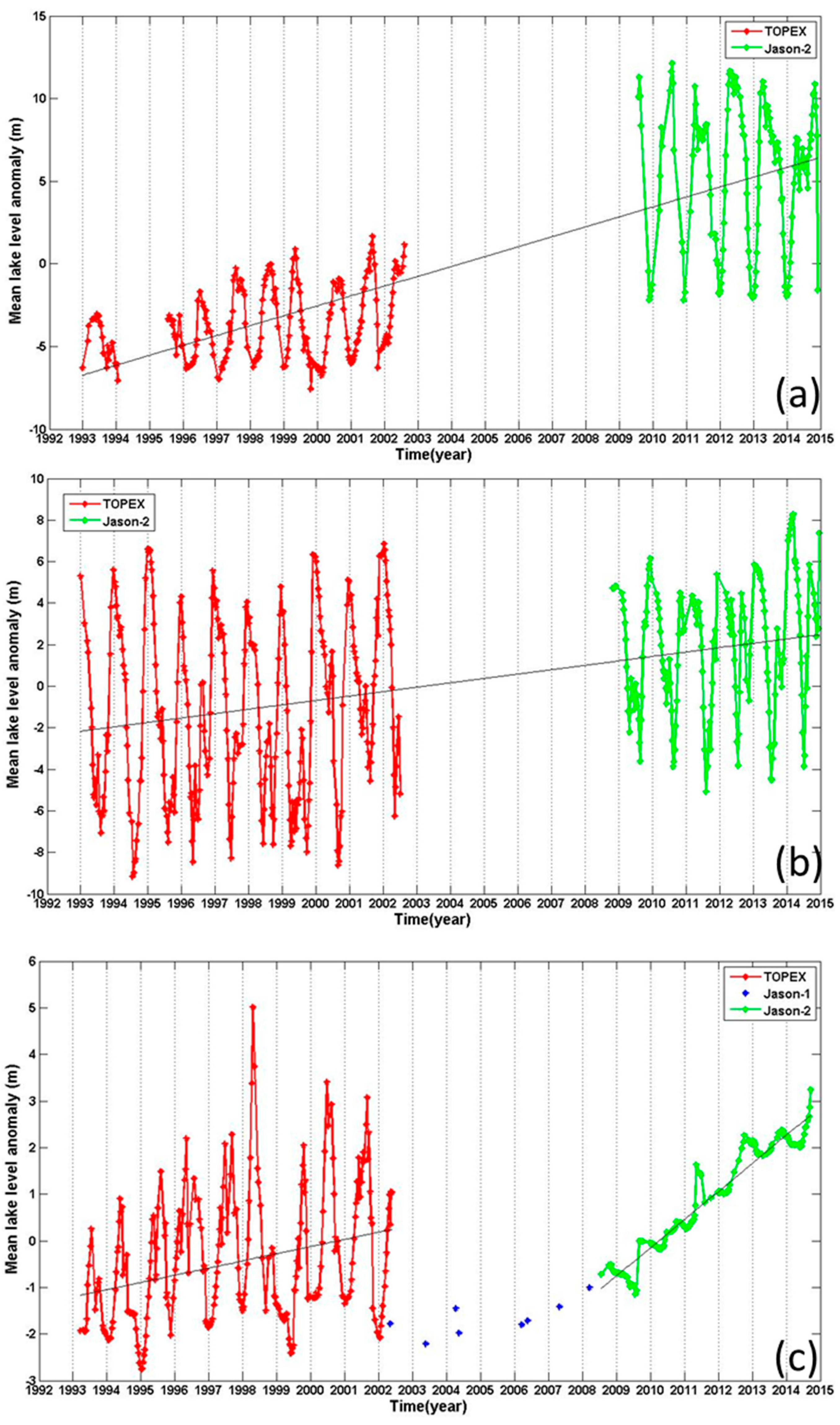

| ID 1 | Name 2 | Approximate Longitude, Latitude | Area (km2) | Track | Approximate Altitude 3 (m) | Reference |
|---|---|---|---|---|---|---|
| 1 | Eling | 97.68, 34.88 | 610.7 | 216, 053 | 4696 | [18] |
| 2 | Kusai | 92.77, 35.78 | 272 | 155 | 5190 | [18] |
| 3 | Cuodarima | 91.85, 35.33 | 89.9 | 064 | 4786 | [18] |
| 4 | Dong | 91.12, 31.61 | 123 | 242 | 5153 | [1] |
| 5 | Zige | 90.90, 32.06 | 234 | 242 | 4579 | [1] |
| 6 | Chibuzhang | 90.09, 33.40 | 520 | 242 | 5377 | [18] |
| 7 | Laorite | 89.95, 33.71 | 57.3 | 242 | 4729 | [18] |
| 8 | Jiuru | 89.94, 31.00 | 40.4 | 155 | 5679 | [19] |
| 9 | Dongqia | 90.40, 31.79 | 46.7 | 155 | 5006 | [20] |
| 10 | Qagoi | 88.19, 31.81 | 88.5 | 166 | 4841 | [1] |
| 11 | Margog Caka | 87.03, 33.86 | 90.7 | 166 | 5043 | [1] |
| 12 | Ngangzi | 87.21, 31.04 | 461.5 | 079 | 4471 | [1] |
| 13 | Zhangnai | 87.40, 31.53 | 36 | 079 | 5197 | - |
| 14 | Dagze | 87.62, 31.88 | 293 | 079 | 4789 | [1] |
| 15 | Gyarab | 87.79, 32.19 | 49 | 079 | 4722 | [11] |
| 16 | Pongyin | 88.18, 32.89 | 48.8 | 079 | 4680 | [21] |
| 17 | Dogai Coring | 89.13, 34.59 | 393.3 | 079 | 5315 | [1] |
| 18 | Zhari Nam | 85.78, 30.93 | 996.9 | 090 | 4823 | [1] |
| 19 | Zhaxi | 85.13, 32.20 | 47.2 | 090 | 4599 | [22] |
| 20 | Gomo | 85.82, 33.66 | 76 | 003 | 5397 | [21] |
| 21 | Qingwa | 86.40, 34.71 | 25.31 | 003 | 5218 | [7] |
| 22 | La’nga | 81.22, 30.66 | 268.5 | 181 | 5145 | [10] |
| 23 | Zhapu | 82.40, 32.56 | 57.9 | 181 | 4550 | - |
| ID1 | Lake | TOPEX/Poseidon | Jason-2 |
|---|---|---|---|
| 1 | Eling | 0.07 ± 0.01 | −0.03 ± 0.01 |
| 2 | Kusai | 0.47 ± 0.14 | 1.58 ± 0.08 |
| 3 | Cuodarima | −0.13 ± 0.05 | 0.51 ± 0.03 |
| 4 | Dong | 0.16 ± 0.03 | 0.61 ± 0.01 |
| 5 | Zige | 0.05 ± 0.08 | 0.12 ± 0.12 |
| 6 | Chibuzhang | 0.15 ± 0.05 | 0.30 ± 0.08 |
| 7 | Laorite | 0.09 ± 0.07 | −0.02 ± 0.02 |
| 8 | Jiuru | 0.21 ± 0.06 | 0.02 ± 0.01 |
| 9 | Dongqia | −0.34 ± 0.08 | −0.08 ± 0.02 |
| 10 | Qagoi | 0.28 ± 0.11 | 0.02 ± 0.02 |
| 11 | Margog Caka | −0.47 ± 0.03 | −2.63 ± 0.8 |
| 12 | Ngangzi | 0.35 ± 0.05 | 0.25 ± 0.01 |
| 13 | Zhangnai | 0.28 ± 0.04 | −0.10 ± 0.12 |
| 14 | Dagze | −0.31 ± 0.06 | 0.08 ± 0.09 |
| 15 | Gyarab | 0.24 ± 0.1 | −0.08 ± 0.08 |
| 16 | Pongyin | 0.10 ± 0.18 | -0.14 ± 0.13 |
| 17 | Dogai Coring | 0.11 ± 0.05 | 0.91 ± 0.16 |
| 18 | Zhari Nam | 0.36 ± 0.01 | −2.05 ± 0.77 |
| 19 | Zhaxi | - | 0.33 ± 0.05 |
| 20 | Gomo | 0.22 ± 0.06 | 0.26 ± 0.16 |
| 21 | Qingwa | 0.00 ± 0.02 | - |
| 22 | La’nga | −0.27 ± 0.01 | −0.09 ± 0.01 |
| 23 | Zhapu | −0.02 ± 0.03 | −0.09 ± 0.03 |
© 2016 by the authors; licensee MDPI, Basel, Switzerland. This article is an open access article distributed under the terms and conditions of the Creative Commons Attribution (CC-BY) license (http://creativecommons.org/licenses/by/4.0/).
Share and Cite
Hwang, C.; Cheng, Y.-S.; Han, J.; Kao, R.; Huang, C.-Y.; Wei, S.-H.; Wang, H. Multi-Decadal Monitoring of Lake Level Changes in the Qinghai-Tibet Plateau by the TOPEX/Poseidon-Family Altimeters: Climate Implication. Remote Sens. 2016, 8, 446. https://doi.org/10.3390/rs8060446
Hwang C, Cheng Y-S, Han J, Kao R, Huang C-Y, Wei S-H, Wang H. Multi-Decadal Monitoring of Lake Level Changes in the Qinghai-Tibet Plateau by the TOPEX/Poseidon-Family Altimeters: Climate Implication. Remote Sensing. 2016; 8(6):446. https://doi.org/10.3390/rs8060446
Chicago/Turabian StyleHwang, Cheinway, Yung-Sheng Cheng, Jiancheng Han, Ricky Kao, Chi-Yun Huang, Shiang-Hung Wei, and Haihong Wang. 2016. "Multi-Decadal Monitoring of Lake Level Changes in the Qinghai-Tibet Plateau by the TOPEX/Poseidon-Family Altimeters: Climate Implication" Remote Sensing 8, no. 6: 446. https://doi.org/10.3390/rs8060446






